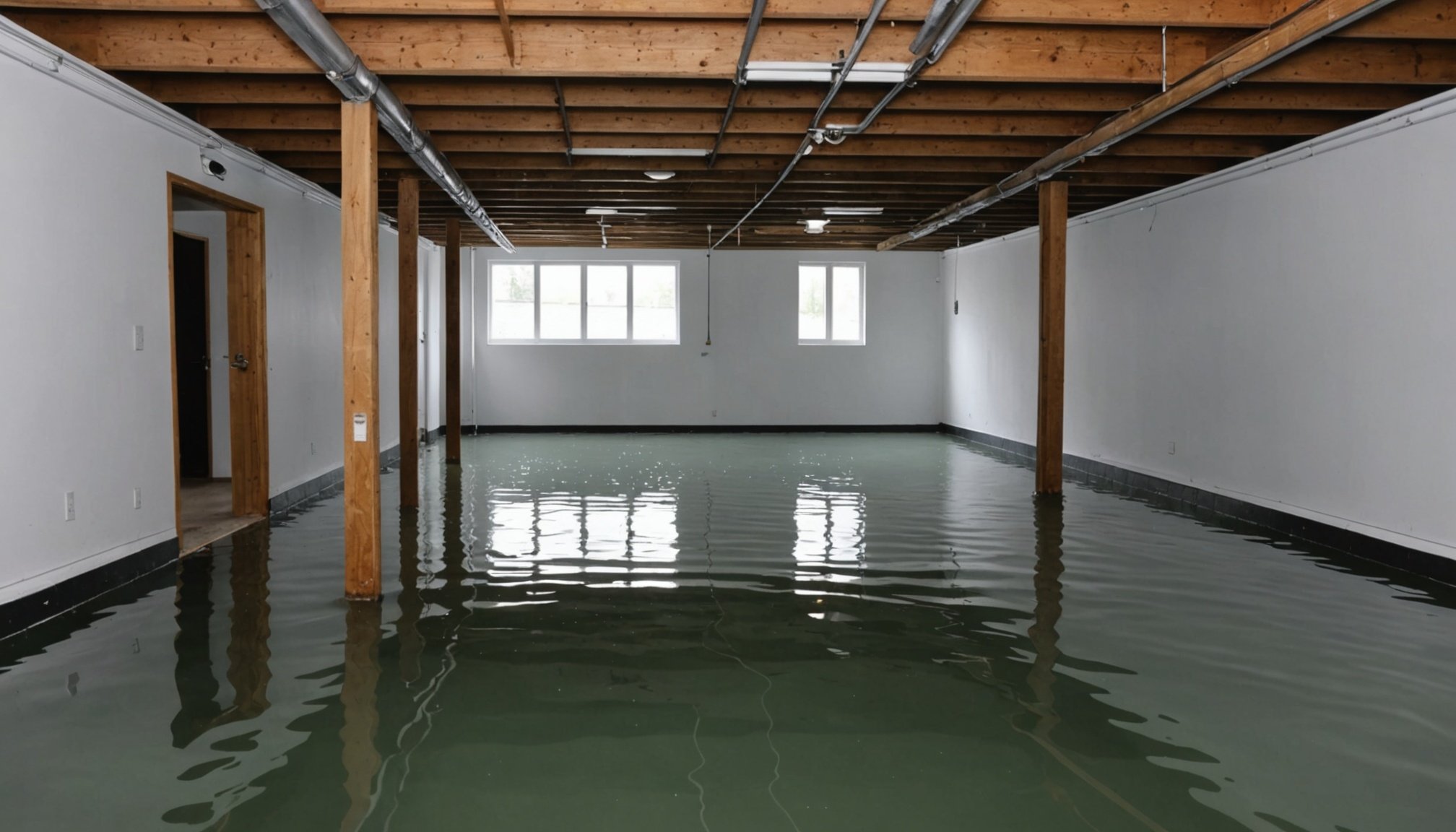Ultimate Guide to Effective Basement Waterproofing Techniques for Flood-Prone Regions
Understanding the Importance of Basement Waterproofing
When you live in a flood-prone region, the last thing you want to worry about is water seeping into your basement. However, this is a reality many homeowners face, and it’s crucial to understand why basement waterproofing is not just a luxury, but a necessity.
“A wet basement can lead to mold, structural damage, musty odors, and a slew of other problems that could turn your dream home into a soggy nightmare,” as highlighted in the Essential Guide to Effective Basement Waterproofing Techniques[4].
Topic to read : Mastering the Art of Space: Ideal Designs for a Versatile Guest Room and Study
Water infiltration can weaken the foundation, walls, and other structural elements of your home over time. It also promotes the growth of mold and mildew, which can pose serious health risks to occupants. Moreover, water damage can reduce the insulation properties of building materials, leading to increased energy consumption for heating and cooling[5].
Types of Basement Waterproofing Methods
There are several methods to waterproof your basement, each with its own set of advantages and considerations.
Also read : Maximizing Natural Heat: Innovative Strategies for Effective Skylight Use
Interior Waterproofing
Interior waterproofing involves applying sealants and coatings inside the basement to prevent water from entering. Here are some key techniques:
- Seal Cracks and Fissures: Use high-quality sealants to close up any cracks in the walls and floor. This is a simple yet effective step that requires hydraulic cement, a putty knife, and some elbow grease[4].
- Installation of a Vapor Barrier: Consider installing a vapor barrier on the walls and floor of your basement. This polyethylene sheeting helps prevent moisture from permeating through, acting like a raincoat for your basement[4].
- Sump Pump Installation: A sump pump is a robust defense against flooding. It collects water in a basin and pumps it away from the foundation. Regular maintenance is crucial to ensure the pump functions correctly[4].
Exterior Waterproofing
Exterior waterproofing is often more extensive but highly effective. Here’s what you need to know:
- Coating of Membranes and Polymers: This involves applying waterproofing membranes and polymers on the exterior walls to protect against leaks and moisture. This method significantly reduces the area for mold and mildew growth and protects your structure from damage[1].
- French Drains: French drains are a type of exterior drainage system that redirects water away from the foundation. This is particularly useful in areas with high water tables or heavy rainfall[5].
- Excavation and Waterproofing: In some cases, it may be necessary to excavate around the foundation to apply waterproofing membranes directly to the exterior foundation walls. This method is more invasive but provides comprehensive protection[2].
Drainage Systems: The Unsung Heroes of Waterproofing
Drainage systems are crucial in keeping your basement dry. Here are some key components:
Gutter Maintenance
Your gutters play a significant role in keeping your basement dry. Clogged gutters and downspouts can cause water to overflow, leading it to cascade down toward your foundation. Regularly clean your gutters to ensure they are free from leaves and debris[4].
Downspout Extensions
Ensure your downspouts direct water at least six feet away from your home. This simple extension can mean the difference between a dry basement and a flooded one[4].
French Drains
French drains are an effective way to redirect water away from your foundation. These systems involve installing pipes inside your basement walls that drain water away from the foundation, preventing hydrostatic pressure build-up[5].
Preventing Water Damage: Practical Tips and Solutions
Preventing water damage is a continuous process that requires regular maintenance and proactive measures.
Annual Inspections
Conduct annual inspections of your basement to check for any signs of leaks, cracks, or mold. This proactive approach can prevent a lot of future headaches and ensure your basement remains dry and healthy[4].
Humidity Control
Using dehumidifiers in your basement can help maintain optimal humidity levels, preventing moisture accumulation. This is especially important in regions with high humidity or during rainy seasons[4].
Tanking and Waterproofing Coatings
Tanking involves applying a waterproof coating to the walls and floor of your basement. This method is particularly effective in areas where water ingress is a significant issue. Waterproofing coatings can be applied both internally and externally to create a watertight barrier[2].
Comparing Interior and Exterior Waterproofing Methods
Here is a detailed comparison of interior and exterior waterproofing methods to help you decide which is best for your home:
| Method | Description | Advantages | Disadvantages |
|---|---|---|---|
| Interior Waterproofing | Applying sealants and coatings inside the basement. | Cost-effective, less disruptive, easy to install. | May not address external water sources, requires regular maintenance. |
| Exterior Waterproofing | Applying membranes and polymers on the exterior walls. | Comprehensive protection, reduces mold and mildew growth, protects structure from damage. | More invasive, higher cost, requires excavation around the foundation. |
| French Drains | Installing pipes to redirect water away from the foundation. | Effective in high water table areas, reduces hydrostatic pressure. | Requires installation inside or outside the basement, can be costly. |
| Sump Pumps | Collecting water in a basin and pumping it away from the foundation. | Robust defense against flooding, easy to maintain. | Requires regular maintenance, can be noisy. |
Real-Life Examples and Success Stories
Understanding the practical application of these methods can be incredibly helpful. Here’s a real-life example:
Imagine a homeowner in a flood-prone area who decided to implement both interior and exterior waterproofing methods. They started by sealing all cracks and fissures in the basement walls and floor, then installed a vapor barrier to prevent moisture from permeating through. On the exterior, they applied waterproofing membranes and installed a French drain system to redirect water away from the foundation. After a heavy rainfall, their basement remained dry, and they avoided the costly repairs and health risks associated with water damage.
Quotes from Experts
- “Waterproofing is not just a mysterious process; it’s grounded in the principles of material science, chemistry, and engineering. By creating impermeable barriers, repelling water molecules, and implementing effective drainage systems, waterproofing professionals provide you with a home that remains dry and secure, no matter the weather.”[2]
- “Effective waterproofing relies on creating a tight seal around vulnerable areas of your home. This seal prevents water from seeping into cracks, joints, or gaps in the building structure.”[2]
Waterproofing your basement is an essential step in protecting your home from the devastating effects of water damage. Whether you opt for interior or exterior methods, or a combination of both, the key is to create a watertight barrier that prevents water from entering your basement.
Here are some final tips to keep in mind:
- Regular Maintenance: Regular inspections and maintenance are crucial to ensuring your waterproofing systems continue to function effectively.
- Consult Professionals: If you’re unsure about the best waterproofing solution for your home, consult with experienced professionals who can guide you through the process.
- Invest in Quality Materials: Using high-quality waterproofing materials can make a significant difference in the effectiveness and longevity of your waterproofing system.
By following these guidelines and understanding the different waterproofing methods available, you can ensure your basement remains dry, healthy, and free from the risks associated with water damage. Remember, a waterproof basement is not just a convenience; it’s a necessity for maintaining the integrity and value of your home.










